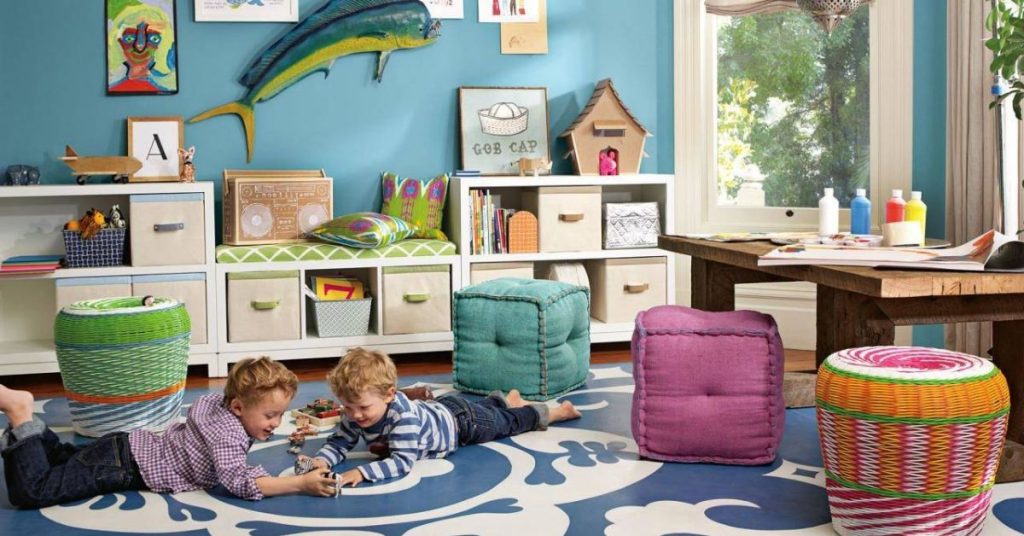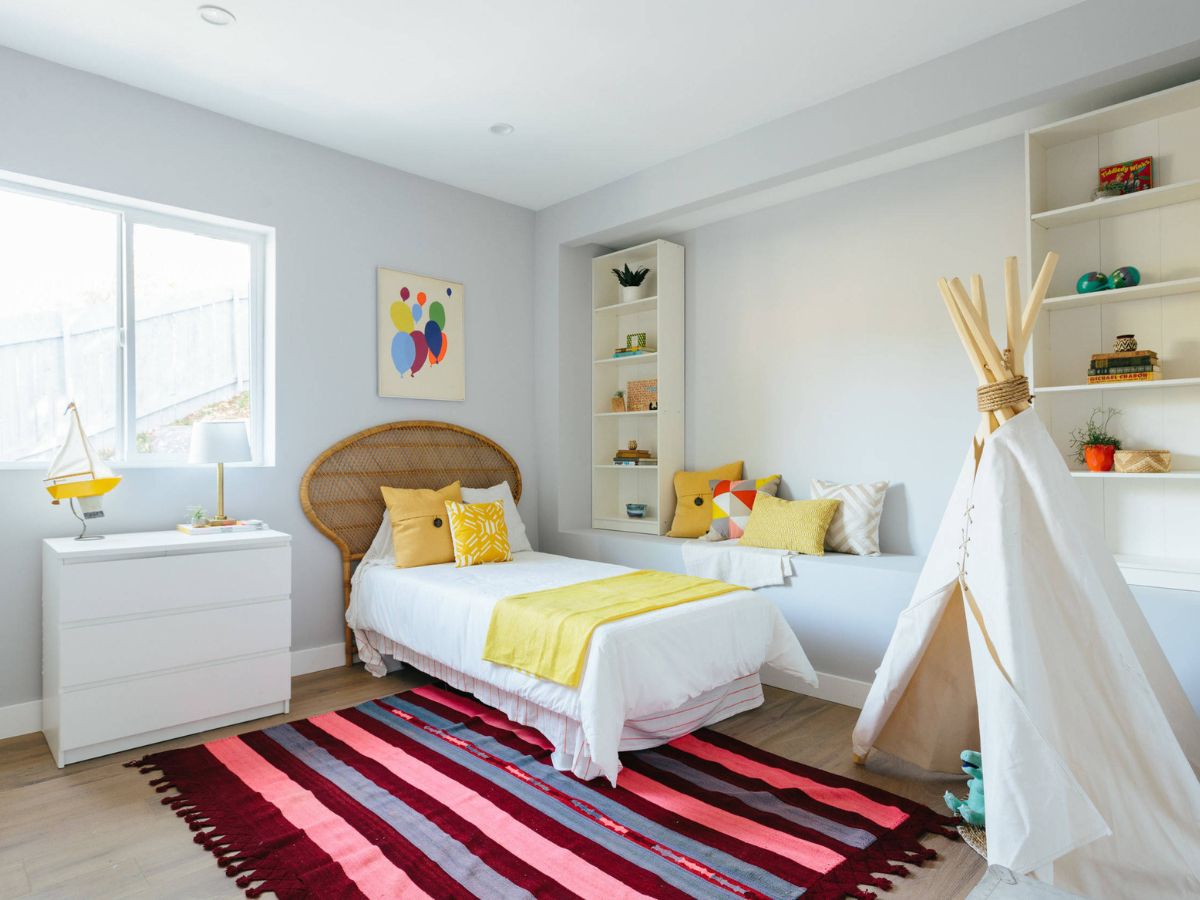Creating a Secure Environment Safety should be the top priority when designing a kid-friendly bedroom. Start by childproofing the room, covering electrical outlets, securing furniture to the walls to prevent tipping, and ensuring there are no sharp edges or choking hazards within reach. Choose non-toxic materials for childrens bed sets and decor, and opt for window treatments that are cordless or have inaccessible cords to prevent accidents. Additionally, consider installing safety gates if the bedroom connects to other areas of the house, and make sure the room is well-ventilated to maintain air quality.
Playful and Functional Furniture Choices:
Selecting furniture that is both playful and functional can enhance your child’s bedroom experience. Look for pieces with rounded edges and durable construction to withstand energetic play. Consider multifunctional furniture like bunk beds with built-in desks or storage compartments to maximize space in smaller rooms. Incorporating whimsical designs or themed furniture can also spark creativity and imagination in children, turning their bedroom into a magical retreat.
Creative Storage Solutions
A clutter-free environment is essential for promoting relaxation and focuses in a child’s bedroom. Invest in creative storage solutions that make it easy for kids to keep their space tidy. Utilize under-bed storage bins, wall-mounted shelves, and colourful bins or baskets to organize toys, books, and clothing. Labeling storage containers with pictures or words can help young children identify where items belong and encourage them to participate in cleaning up. Make sure storage solutions are easily accessible to children to foster independence in maintaining their space.
Personalized Decor and Themes
Infuse your child’s personality into their bedroom decor by incorporating personalized touches and themed elements. Let your child choose a theme or colour scheme that reflects their interests, whether it’s superheroes, princesses, outer space, or animals. Use wall decals, posters, and bedding to bring the theme to life, creating a cohesive and inviting space. Display your child’s artwork or crafts to add a personal touch and boost their self-esteem. Encourage collaboration by involving your child in decorating decisions, fostering a sense of ownership and pride in their bedroom.
Soft and Comfortable Bedding
Comfortable bedding is crucial for promoting restful sleep and relaxation in a kid-friendly bedroom. Opt for soft, breathable fabrics like cotton or microfiber for sheets, pillowcases, and blankets. Consider investing in a high-quality mattress suited to your child’s age and sleeping preferences. Whether it’s a twin, full, or bunk bed size. Choose pillows and stuffed animals that are hypo allergenic and easy to clean. Additionally, incorporate cosy pug dog throw blankets and accent pillows to add warmth and texture to the bedding ensemble. Creating a welcoming and inviting sleep environment.
Interactive Learning Spaces
Transform your child’s bedroom into an interactive learning environment that stimulates their curiosity and creativity. Designate a corner or area for educational activities and exploration, such as a reading nook with a comfortable chair or bean bag and a bookshelf stocked with age-appropriate books. Incorporate learning tools like chalkboards, whiteboards, or easels for drawing and writing activities.
Consider adding educational posters, maps, or charts to the walls to reinforce academic concepts in a fun and engaging way. Encourage hands-on learning through puzzles, building blocks, and other interactive toys that promote problem-solving skills and cognitive development.

Easy-to-Access Books and Toys
Foster a love of reading and play by ensuring books and toys are easily accessible to your child in their bedroom. Install low bookshelves or bookcases within reach of your child, organizing books by genre, author, or reading level to encourage independent exploration. Use clear bins or baskets for storing toys and games, labeling each container with pictures or words to help children identify and retrieve items on their own. Rotate toys regularly to keep playtime fresh and exciting, and encourage your child to engage in imaginative play by providing open-ended toys like dolls, action figures, or building sets.
Adjustable Lighting Options
Lighting plays a crucial role in setting the mood and atmosphere in a kid-friendly bedroom. Incorporate adjustable lighting options to accommodate different activities and preferences throughout the day. Install overhead lighting with dimmer switches to control brightness levels and create a cosy ambience for bedtime stories or quiet play. Add task lighting near study areas or desks to provide focused illumination for homework or creative projects.
Consider incorporating nightlights or bedside lamps with soft, warm hues to provide comfort and reassurance during nighttime hours. Encourage your child to customize their lighting preferences to suit their mood and activities. Empowering them to create a personalized sanctuary.
Technology Management
With the prevalence of digital devices, it’s important to establish healthy boundaries and manage technology use in your child’s bedroom. Create designated tech-free zones within the bedroom to promote relaxation and sleep hygiene, keeping TVs, computers, and video game consoles out of the sleeping area. Establish screen time limits and encourage alternative activities like reading, creative play, or outdoor exploration.
Consider implementing parental controls or setting up a charging station outside the bedroom to discourage late-night use of digital electronic devices. By fostering a balanced approach to technology, you can promote healthy habits and prevent sleep disturbances in your child’s bedroom.
Encouraging Independence and Organization
Empowering your child to take ownership of their bedroom fosters a sense of independence and responsibility. Encourage age-appropriate chores like making the bed, tidying up toys, and organizing belongings to instil good habits from a young age. Provide child-sized furniture and storage solutions that are easy for your child to use independently, such as low-hanging clothing racks or drawers with accessible handles.
Incorporate visual cues like colour-coded bins or labels to help your child identify where items belong and maintain organization. Celebrate small victories and praise your child for their efforts in keeping their bedroom clean and organized. Reinforcing positive behaviours and building confidence. By promoting independence and organization, you can create a functional and harmonious space that supports your child’s growth and development.
Also, read: What are Best Materials Used for Bedding at Home?

